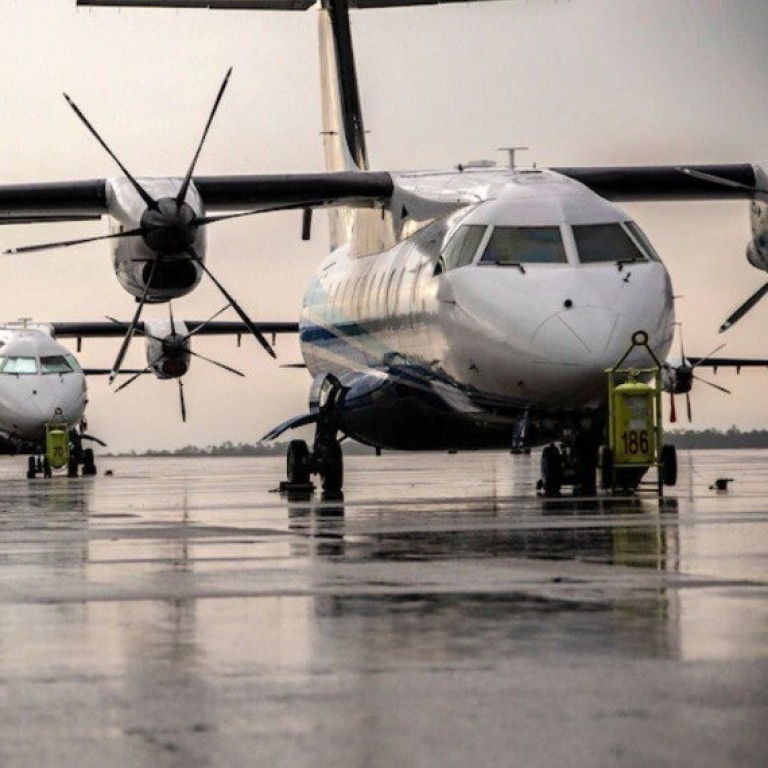
Beijing angered by US Air Force plane’s short stop in Taiwan as de facto ambassadors change over
- As director of the American Institute in Taiwan Brent Christensen leaves and Sandra Oudkirk arrives, Beijing lets its anger be known
- Observers say the openness of the 30-minute ‘touch-and-go’ visit was a sign of deepening US-Taiwan relations
The US Air Force’s C-146A Wolfhound landed at Taipei Songshan Airport in the island’s capital city for about 30 minutes on Thursday morning, according to airport officials.
Both AIT and Taiwan’s foreign ministry declined to comment on the arrival of the US transport plane. Taiwan’s air force said it had not handled the arrival of the US plane and had only learned of the flight after it landed at Taipei airport.
Local news media said the plane, which took off from the US Kadena Air Base in Japan’s Okinawa, made a delivery to AIT to help Oudkirk assume the post at the de facto embassy.
Oudkirk, who arrived in Taiwan on Monday, will report for duty after completing 14 days of quarantine and seven days of self-health management in line with the island’s Covid-19 prevention measures, AIT said in a statement on Thursday.
US draws clear line on Taiwan but China will still have cause to worry
Thursday’s stopover enraged Beijing which has time and again warned the US against having official contact or helping militarise Taiwan.
“Taiwan is a sacred and inalienable part of Chinese territory. Any foreign military aircraft must get permission from the government of the People’s Republic of China to land on our territory,” the mainland defence ministry said in a statement.
“The US is now playing with fire and must stop any risky and provocative actions immediately,” it said, adding that the US should never send the wrong signal to Taiwan independence separatist forces and must avoid aggravating tensions in the Taiwan Strait.
It also said the People’s Liberation Army would take all necessary measures to resolutely crush any “Taiwan independence” intentions on the island.
Observers said Thursday’s stopover reflected that the “rock solid” US-Taiwan relations had been elevated to another level.
Alexander Huang Chieh-cheng, a professor of international relations and strategic studies at Tamkang University in Taipei, said the transport plane would not take Christensen back to the US because it was not in keeping with protocol.
For Thursday’s stopover to have been brought to light, it might signal that the US was increasingly unconcerned about Beijing’s reaction – a sure sign of deepening US-Taiwan relations.
“Washington has been doing whatever they see fit for a long time,” Huang said, adding: “Taiwan as the receiving end does not have too much, if any, flexibility in the process.”
Timeline: Taiwan’s relations with mainland China under Tsai Ing-wen
Of the “touch-and-go” visit, Huang said if the US plane was delivering something to Taiwan as reported, “it must be something very sensitive that would be unsafe to be transported through regular civilian carriers”.
In addition to the US approving US$18.3 billion worth of arms sales to Taiwan, it adopted a series of Taiwan-friendly bills and measures under Christensen’s watch, including giving permission for high-level official exchanges between the two sides and allowing the State Department to issue new guidelines for official contact with Taiwanese counterparts.
Christensen helped Taiwan and the US hold the first Pacific Islands Dialogue, the Economic Prosperity Partnership Dialogue and sign a memorandum of understanding on coastguard cooperation.
Then-US secretary of health Alex Azar and undersecretary of state Keith Krach visited Taiwan in August and September respectively to become among the highest-level US officials to visit since 1979.
On Thursday, AIT said Oudkirk “brings with her a wealth of experience from her 30-year career in the US Foreign Service, a deep understanding of the East Asian and Pacific region and a commitment to and passion for diplomacy. She looks forward to building on the successes of her predecessors and to further advancing the US-Taiwan relationship.”


